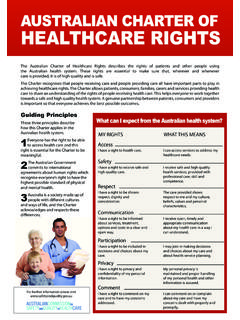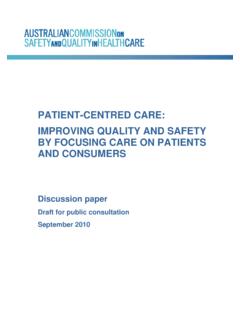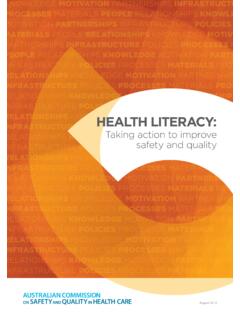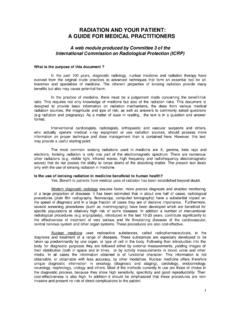Transcription of National Standard for User-applied Labelling of Injectable ...
1 National Standard for User-applied Labelling of Injectable Medicines, Fluids and Lines Commonwealth of Australia 2015. This work is copyright. It may be reproduced in whole or in part for study or training purposes subject to the inclusion of an acknowledgement of the source. Requests and inquiries concerning reproduction and rights for purposes other than those indicated above require the written permission of the Australian Commission on Safety and Quality in Health Care, GPO Box 5480, Sydney, NSW 2001 or ISBN 978-1-925224-17-7 (print), 978-1-925224-18-4 (online). Suggested citation Australian Commission on Safety and Quality in Health Care. National Standard for User-applied Labelling of Injectable Medicines, Fluids and Lines. Sydney: ACSQHC, 2015.
2 Acknowledgement Many individuals and organisations have freely given their time and expertise to support the development of this document. In particular, the Commission wishes to acknowledge state and territory contacts who have coordinated implementation, and health services that have fed back implementation experiences, which are reflected in this document. The involvement and willingness of all concerned to share their experience and expertise are greatly appreciated. The National Standard for User-applied Labelling of Injectable Medicines, Fluids and Lines ( Labelling Standard ) and support materials are available on the Commission web site at The Labelling Standard supersedes the National Recommendations for User-applied Labelling of Injectable Medicines, Fluids and Lines, first edition (August 2010) and second edition (February 2012).
3 National Standard for User-applied Labelling of Injectable Medicines, Fluids and Lines CONTENTS. Acronyms and vi Properties of Label Label Executive Label Preprinted 1 3 Colour coding ..10. Administration errors with Route of Injectable medicine 11. Administration errors in the perioperative 4. 4 Labelling Injectable Support for safe Labelling medicine 16. 4. General considerations for all Standardisation and colour containers .. 16. coding of medicine National Safety and Quality fluid 16. Health Service 17. National Medicines Containers in open- and closed- Labelling Standard context ..6 practice 17. Labelling Standard When to discard containers of Injectable 17. Minimum requirements for Labelling 2 Scope of the Labelling containers in the open-practice 7 18.
4 Minimum requirements for Labelling containers in the closed-practice 19. Injectable 19. 3 General requirements for Non- Injectable medicines 9 and 19. National Standard for User-applied Labelling of Injectable Medicines, Fluids and Lines iii 5 Labelling Injectable 7 Specific medicine conduits, lines Containers and lines on and catheters .. 20. sterile fields outside the perioperative 31. Minimum requirements for Labelling Catheter 31. Administration 21 Cytotoxic 31. Administration lines and 32. catheters to identify 21. Administration lines to Blood 32. identify 21. Label placement for Non- Injectable medicines administration 22 and 32. Oral and enteral 32. Invasive monitoring 23. Inhalation 33. Minimum requirements for Topical 33. Labelling invasive monitoring 23 Labelling at transitions of 33.
5 Locked 23 Labelling in an 33. Minimum requirements for Labelling locked 23. Other catheters and 24. Pulmonary artery 24 Intracranial pressure monitoring 24. Appendix 1. Extraventricular and lumbar Label guide and specifications ..38. 24. Bladder irrigation 24. Appendix 2. Specifications for preprinted abbreviated container 6 Labelling in perioperative Appendix 3. Open- and closed-practice The Labelling Standard and 25 other 44. Containers on perioperative sterile 27 Appendix 4. Labelling Standard development Interventional cardiology, and radiology and other low-light procedure 28 Contrast Reusable Using preprinted iv Australian Commission on Safety and Quality in Health Care Tables Figures Table 1 Colour coding of User-applied Figure 1 Examples of containers and labels for target tissue.
6 11 conduits for Injectable medicines that require Table 2 User-applied label colours for User-applied 7. syringes containing medicines used during anaesthesia Figure 2 User-applied Labelling of (adapted from medicines and fluids in the ISO 26825:2008)..12 open- and closed-practice environments of the Table 3 Examples of preprinted perioperative medicine line Figure 3 Examples of preprinted Table Modifications to AS 4940 abbreviated container labels used in the Labelling for User-applied identification Standard : background and in the closed-practice Table Modifications to AS 4940 Figure 4 Generic abbreviated container used in the Labelling label for User-applied Standard : colour for target identification in the closed- 46 practice environment ..28. Table Anaesthetic Labelling Standard Figure 5 Examples of preprinted labels colour coding to medicines in cardiac catheter lines labels and abbreviated container labels used outside Figure 6 Contrast media abbreviated container 30.
7 Figure 7 Line label for medicine used to lock' a Figure 8 Label for enteral Figure 9 Label for inhalation National Standard for User-applied Labelling of Injectable Medicines, Fluids and Lines v Acronyms and abbreviations Anaesthetic Labelling International Standard ISO 26825:2008 Anaesthetic and respiratory Standard equipment User-applied labels for syringes containing drugs used during anaesthesia colours, design and performance AS 4940:2002 Australian Standard AS 4940:2002 User-applied identification labels for use on fluid bags, syringes and drug administration lines the Commission Australian Commission on Safety and Quality in Health Care the Labelling National Recommendations for User-applied Labelling of Injectable Recommendations Medicines, Fluids and Lines the Labelling Standard National Standard for User-applied Labelling of Injectable Medicines, Fluids and Lines PMS Pantone Matching System vi Australian Commission on Safety and Quality in Health Care Executive summary Injectable medicines are a high-risk therapy for The Labelling Standard sets out the requirements patients and health professionals.
8 It is reported for label format, content and placement. The aim that 25% of all medication incidents in acute care is to: involve Injectable medicines, but nearly 60% of promote safer use of Injectable medicines medication errors that result in serious patient provide standardisation for User-applied harm or death involve Injectable medicines (1). Labelling of Injectable medicines Incomplete or inaccurate Labelling of Injectable provide minimum requirements for user- medicines and fluids (and the devices used to applied Labelling of Injectable medicines. deliver them) is a recognised risk to the safe administration of medicines and is potentially The Labelling Standard addresses one preventable. Improved Labelling can reduce the recognised risk point in the safe administration risk of error and harm by safely communicating of Injectable medicines by preventing medicine the contents of Injectable medicines containers administration errors, such as wrong patient, and the patients for whom they are intended (2).
9 Wrong route, wrong medicine or wrong dose. It applies alongside other safe medicines practices. One way of ensuring accurate communication of Injectable medicines and fluids information is by standardised User-applied Labelling . This Practice principles National Standard for User-applied Labelling of Injectable Medicines, Fluids and Lines (the The Labelling Standard is based on the following Labelling Standard ) has been developed as a practice principles: National solution to the risks posed by erroneous All medicines and fluids removed from the administration of Injectable medicines. It replaces manufacturer's or hospital pharmacy's original the 2012 National Recommendations for User- packaging must be identifiable. applied Labelling of Injectable Medicines, Fluids All containers ( bags, syringes) containing and Lines (the Labelling Recommendations) (3).
10 Medicines leaving the hands of the person preparing the medicine must be labelled. Aims Only one medicine at a time should be prepared and labelled before the preparation The Labelling Standard is designed to reduce and Labelling of a subsequent medicine . the risk of patient harm from Injectable medicines by helping healthcare professionals identify the Any medicine or fluid that cannot be identified correct: ( in an unlabelled syringe or other container) is considered unsafe and should be Injectable medicine or fluid (container). discarded. route of administration of the Injectable medicine (conduit). patient for whom the medicine is intended. National Standard for User-applied Labelling of Injectable Medicines, Fluids and Lines 1. Labelling requirements National Safety and Quality Health Service Standards The Labelling Standard sets out the requirements for User-applied Labelling of: Implementation of the Labelling Standard is a containers of Injectable medicines and fluids mandatory requirement for meeting the National (bags, bottles and syringes) that can no longer Safety and Quality Health Service Standards (5).











